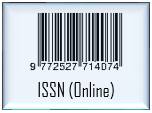SIMPLE AND RAPID METHOD FOR ISOLATING ANTHOCYANIN FROM WILD MULBERRY (Morus nigra L.)
(1) Farmasi Universitas Ma Chung
(2) Farmasi Universitas Ma Chung
(3) Farmasi Universitas Ma Chung
(4) Farmasi Universitas Ma Chung
(5) Farmasi Universitas Ma Chung
(*) Corresponding Author
Abstract
Wild mulberry (Morus nigra L.) is a kind of berries that has a high content of anthocyanin pigment. Anthocyanin is a natural pigment that has good biological activity so that widely be used as both food and drug ingredients. There are many studies conducted that have isolation anthocyanin from mulberry extract, but most of them used various expensive methods and the process included several steps that make them not cost-effective nor time-efficient. This research was conducted in order to do an isolation of anthocyanin from wild mulberry through a single step. The extraction of compounds was done by maceration and the isolation was done by thin layer chromatography method. The isolation product was identified with reagents, consisting of ferric chloride and sodium hydroxide, and with spectrophotometry methods, consisting of UV-Vis and infrared spectrophotometry. As result, this research was able to isolate anthocyanin from wild mulberry fruit by thin layer chromatography method. The identification with spectrophotometry methods indicated that the isolated compound hypothetically was anthocyanidin-3-O-rutinoside.
Keywords
Full Text:
PDFReferences
Bondre S., Patil P., Kulkarni A., and Pillai M.M., 2012. Study on isolation and purification of anthocyanins and its applications as pH indicator. International Journal of Advanced Biotechnology and Research, 3(3), 698702.
Csedas G., Les F., Gmez-Serranillos M.P., Smith C., and Lpez V., 2017. Anthocyanin profile, antioxidant activity and enzyme inhibiting properties of blueberry and cranberry juices: A comparative study. Food and Function, 8(11), 41874193.
Chang H., Kao M.-J., Chen T.-L., Chen C.-H., Cho K.-C., and Lai X-R., 2013. Characterization of Natural Dye Extracted from Wormwood and Purple Cabbage for Dye-Sensitized Solar Cells, International Journal of Photoenergy.
Field L.D., Sternhell S., and Kalman J.R., 2008. Organic Structures from Spectra. 4th ed. Chichester: John Wiley and Sons.
Huang W., Zhang S., Qin G., Wenquan L., and Wu J., 2012. Isolation and determination of major anthocyanin pigments in the pericarp of P. communis L. cv. Red Du Comices and their association with antioxidant activity. African Journal of Agricultural Research, 7(26), 37723780.
Kendrick A., 2016. Coloring Aqueous Food Types, in: Handbook on Natural Pigments in Food and Beverages: Industrial Applications for Improving Food Color, Elsevier Ltd, 163-177.
Khoo H.E., Azlan A., Tang S.T., and Lim S.M., 2017. Anthocyanidins and anthocyanins: colored pigments as food, pharmaceutical ingredients, and the potential health benefits. Food & Nutrition Research, 61(1).
Miguel M.G., 2011. Anthocyanins: Antioxidant and/or anti-inflammatory activities. J. App. Pharm. Sci., 1(6), 715.
Obouayeba A.P., Diarrassouba M., Soumahin E.F., and Kouakou H., 2015. Phytochemical Analysis , Purification and Identification of Hibiscus Anthocyanins. Journal of Pharmaceutical, Chemical and Biological Sciences, 156168.
Pervaiz T., Songtao J., Faghihi F., Haider M.S., and Fang J., 2017. Naturally Occurring Anthocyanin, Structure, Functions and Biosynthetic Pathway in Fruit Plants. Journal of Plant Biochemistry & Physiology, 5(2).
Qin C., Li Y., Niu W., Ding Y., Zhang R., and Shang X., 2010. Analysis and characterisation of anthocyanins in mulberry fruit. Czech Journal of Food Sciences, 28(2), 11726.
Roobha J., Saravanakumar M., Aravindhan K.M., and Suganya D.P., 2011. In vitro evaluation of anticancer property of anthocyanin extract from Musa acuminate bract. Research in Pharmacy, 1(4), 1721.
Sitepu R., Brotosudarmo T.H.P., and Limantara L., 2016. Karakterisasi Antosianin Buah Murbei Spesies Morus alba dan Morus cathayana di Indonesia (Anthocyanin Characterization of Morus alba and Morus cathayana in Indonesia ). Online Journal of Natural Science, 5(2), 158-171.
Thi N.D., and Hwang E.S., 2018. Effects of black chokeberry extracts on metastasis and cell-cycle arrest in SK-Hep1 human liver cancer cell line. Asian Pacific J. Trop. Biomed., 8(6), 285291.
Wahyuningsih S., Wulandari L., Wartono M.W., Munawaroh H., and Ramelan A.H., 2017. The Effect of pH and Color Stability of Anthocyanin on Food Colorant. In IOP Conference Series: Materials Science and Engineering. 193(1).
Yan F., Chen Y., Azat R., and Zheng X., 2017. Mulberry Anthocyanin Extract Ameliorates Oxidative Damage in HepG2 Cells and Prolongs the Lifespan of Caenorhabditis elegans through MAPK and Nrf2 Pathways. Oxidative Medicine and Cellular Longevity.
DOI: https://doi.org/10.24071/jpsc.001675
Refbacks
- There are currently no refbacks.
Copyright (c) 2019 Jurnal Farmasi Sains dan Komunitas (Journal of Pharmaceutical Sciences and Community)
Jurnal Farmasi Sains dan Komunitas (Journal of Pharmaceutical Sciences and Community)
Published by Faculty of Pharmacy, Universitas Sanata Dharma Yogyakarta

This work is licensed under a Creative Commons Attribution 4.0 International License.













.png)













